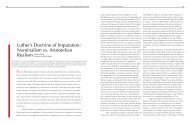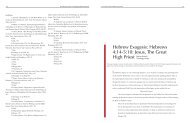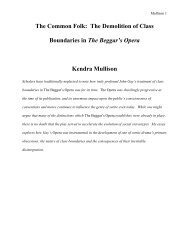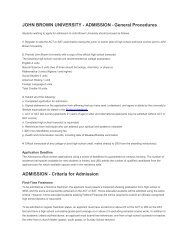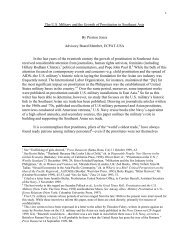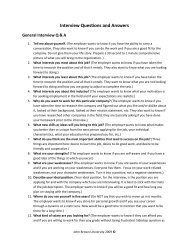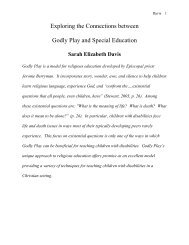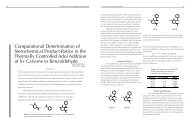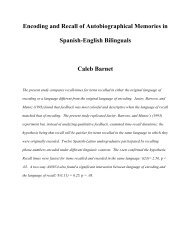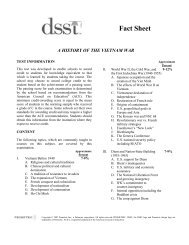Racine's Phaedra: Here There Be Monsters
Racine's Phaedra: Here There Be Monsters
Racine's Phaedra: Here There Be Monsters
Create successful ePaper yourself
Turn your PDF publications into a flip-book with our unique Google optimized e-Paper software.
Macfarlan 2The theme of monsters is introduced at the beginning of <strong>Phaedra</strong> via the ideal ofmonster-slaying: an ideal to which Hippolyte, <strong>Phaedra</strong>, and Theseus all aspire. Providing asetting to the story is Theseus’s heroic past—not greatly described in the text, but idolized byHippolyte. As Hippolyte recalls:Men’s longing for another Hercules—Those monsters slain, those brigands all undone.(Racine 1.1.78-79).Unfortunately, Theseus’ many conquests are not limited to the heroic realm, but includethe romantic; Hippolyte also speaks of Theseus’a infidelity. King Theseus is described both asmonster-killer and faithless lover; as Erica Harth notes, Hippolyte “indicates a wish to emulatehis father in the former role” (21), proving himself a hero to become worthy of Aricia’s love.Racine, as a writer of the Enlightenment, viewed the ancient story of Theseus through thelens of his age. The Enlightenment period, also called the Age of Reason, was preoccupied withmankind’s quest to triumph over what society considered barbarian—the superstitious andillogical: metaphorical monsters. Racine’s Theseus is a hero not only for slaying literal monsters,but metaphorical ones: the “brigands” and barbarians threatening Greek civilization. Armed withsteely determination to keep his throne, Theseus killed all fifty of Aricia’s brothers when theythreatened to overthrow his line. The monsters menacing the characters of <strong>Phaedra</strong> are the samethat Neoclassical society feared: chaos and irrationality.<strong>Phaedra</strong>, in addition to Hippolyte, expresses the desire to kill the monster. Possessed by aperverse lust for her stepson, she fantasizes about Hippolyte, not Theseus, slaying the Minotaurin the Labyrinth of King Minos:You would have slain the Cretan monster then,
Macfarlan 4between the two passions by showing their effects. As Thomas J. Braga notes, “Thecrystallization of Phédre’s love for Hippolyte…has not transformed her into a moreunderstanding, caring, and tender person as it has Hippolyte and Aricia. Rather, love has madePhédre see monsters” (293). <strong>Phaedra</strong> is a tragic character because this monster—jealous,impossible lust—represents the loss of her humanity to the bestial.Monster-slaying is also an ambition held by Theseus. As a hero who has in the pasttriumphed over beasts and barbarians, he is determined to pluck out any irrational thing thatthreatens his kingdom. When Oenone lies to Theseus, claiming that Hippolyte is the one lustingafter <strong>Phaedra</strong>, the king brands his son a literal monster, calling upon the gods to slay him:Monster, at whom Jove’s thunder should be hurled!Foul brigand, like those of whom I cleaned the world!(Racine 4.2.11-12).Hippolyte desires to slay the monster in order to prove himself; <strong>Phaedra</strong> wants the monster she isbecoming to be slain; and Theseus is determined to slay the monster of irrationality.Another monster looms in the play’s backdrop: the Minotaur. The dark story of KingMinos’ Labyrinth, though only alluded to in the text, provides important setting to the charactersof <strong>Phaedra</strong>. The Minotaur killed by Theseus was a monster begat by a monstrous desire:Pasiphae’s lust for and copulation with a bull. King Minos built the walls of his Labyrinth to hidehis wife’s bestial passion, and Elissa Marder identifies <strong>Phaedra</strong>’s attempts to conceal her lovefrom Oenone as a kind of labyrinth-building, as well: “Phédre’s response…seems at first like onemore circumlocution. Instead of beginning to speak about her own illicit desire, she speaks abouther mother and her mother’s desire” (60). As Pasiphae’s daughter, and therefore the Minotaur’shalf-sister, <strong>Phaedra</strong> is haunted by an inescapable legacy.
Macfarlan 6But Theseus, <strong>Phaedra</strong>, and Hippolyte are all foiled in their fierce resolve to kill themonster. The crushing tragedy in <strong>Phaedra</strong> arrives when, just after his innocence is realized,Hippolyte is slain by the sea-monster. Theseus’s conception of Hippolyte as a beast was grosslyinaccurate, and in his death, the bestial has truly triumphed over humanity. As Harth observes,regardless of what the monster-metaphor symbolizes, Hippolyte’s gruesome death by seamonsterdemonstrates that an “irrational force has won out” (21). The Herculean Theseus haslost the battle. Hippolyte, too, has failed to kill the monster—failing to prove himself as a hero.His defeat is humiliating and absolute. In a final cruel twist, Hippolyte’s mangled corpse is“lacking form or hue” (Racine 5.7.92), so that even Aricia cannot recognize him: in a way, thebeast has stripped Hippolyte of his humanity. <strong>Phaedra</strong>, too, has failed to kill the monster she sawin herself. Determined to win victory in some small way, she drinks poison, but irrationality hasstill triumphed. In the moment that the sea-monster rises from the waves to slay Hippolyte, themetaphorical monsters of the play have become literal. <strong>Phaedra</strong> is a tale of monsters, but theliteral ones are only representative of the metaphorical ones. Krystian Czerniecki traces theetymology of “monster” to suggest that Racine intended a moral lesson: “Monstre derives fromthe Latin monstrum…to instruct or teach…[In] Phédre…Racine demonstrates the imbrication ofthe monster and the moral monitor” (1014). Ultimately, the triumph of the sea-monsterrepresents the triumph of the irrational beast over reason, making <strong>Phaedra</strong> a compelling tragedyfor Racine’s audience and audiences today.On the surface, the conflict in <strong>Phaedra</strong> may appear to occur between Theseus andHippolyte, or <strong>Phaedra</strong> and Hippolyte, or perhaps Theseus and <strong>Phaedra</strong>. However, the tragedystems not from these interactions or any others, but from the battle between monsters andhumanity. And what were these monsters? Superstition. Chaos. Irrationality. Perhaps what truly



